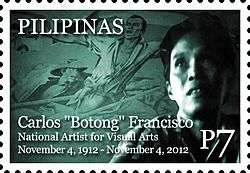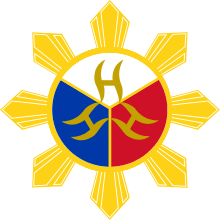Botong Francisco
Carlos Modesto "Botong" Villaluz Francisco[2] (November 4, 1912 – March 31, 1969) was a muralist from Angono, Rizal.
Carlos "Botong" Francisco | |
|---|---|
 Francisco on a 2012 stamp of the Philippines | |
| Born | Carlos Modesto Villaluz Francisco November 4, 1912 Angono, Rizal, Philippine Islands |
| Died | March 31, 1969 (aged 56) Angono, Rizal, Philippines |
| Resting place | Heroes' Cemetery, Taguig, Philippines[1] |
| Nationality | Filipino |
| Other names | Botong |
| Occupation | Painter/Muralist |
| Parent(s) | Felipe Francisco (father) Maria Villaluz (mother)[2] |
| Awards |  National Artist of the Philippines |
Early life
Francisco was a most distinguished practitioner of mural painting for many decades and best known for his historical pieces. He was one of the first Filipino modernists along with Galo Ocampo and Victorio C. Edades who broke away from Fernando Amorsolo's romanticism of Philippine scenes. According to restorer Helmuth Josef Zotter, Francisco's art "is a prime example of linear painting where lines and contours appear like cutouts."[3]
Later Career
He was responsible for the discovery of the now famous Angono Petroglyphs in 1965. He was also involved in Costume Design in Philippine cinema.
His great works include portrayals of the Blood Compact, First Mass at Limasawa, The Martyrdom of Rizal, Bayanihan, Magpupukot, Fiesta, Bayanihan sa Bukid, Sandugo, Portrait of Purita, The Invasion of Limahong, Serenade, and Muslim Betrothal. Some of his murals have suffered big damage over the years. The "Pageant of Commerce" emerged from several years of restoration in 2000.[3]
His murals, The Progress of Medicine in the Philippines, was restored for the 3rd time in 2007 and is currently residing in the National Art Gallery of the Philippines. A high-quality replica of the mural is also located at its previous location at the lobby of the Philippine General Hospital.[4] [5]
Death
Botong died on March 31, 1969 in Angono, Rizal, Philippines.
Gallery
- First Mass at Limasawa
- The Progress of Medicine in the Philippines
- The Progress of Medicine in the Philippines (1st Panel)
- The Progress of Medicine in the Philippines (2nd Panel)
- The Progress of Medicine in the Philippines (3rd Panel)
- The Progress of Medicine in the Philippines (4th Panel)
| Wikimedia Commons has media related to Botong Francisco. |
References
- Francisco, Carlos Modesto (1989). Botong: Alay at Alaala. Coordinating Center for the Visual Arts of the Cultural Center of the Philippines. p. 5. ASIN B0006EWXAK.
- Francisco, Carlos Modesto (1989). Botong: Alay at Alaala. Coordinating Center for the Visual Arts of the Cultural Center of the Philippines. p. 1. ASIN B0006EWXAK.
- Alex Y. Vergara (July 24, 2000) "How to Save a Botong Francisco," Philippine Daily Inquirer
- Allison Lopez (August 30, 2007) "Art docs work on ‘dying’ Botong murals in PGH," Inquirer
- Nikki Francisco (September 26, 2017) "10 Must-See Masterpieces at the National Museum of the Philippines" Spot.ph